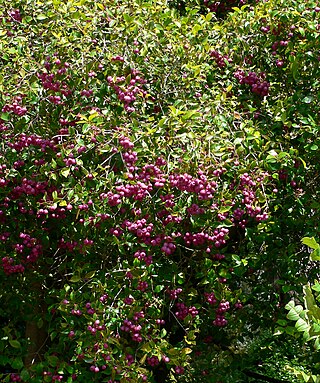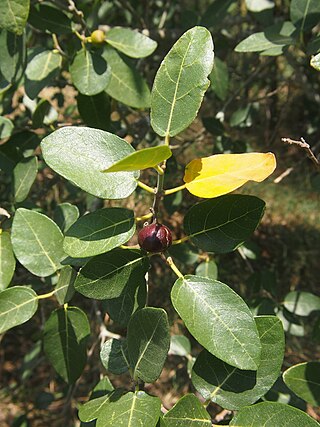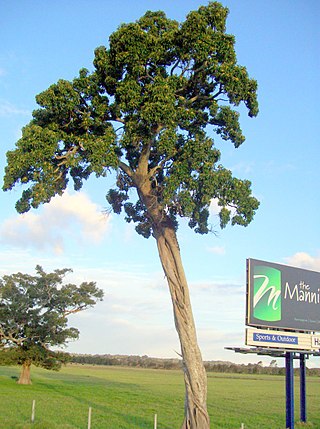
Ficus is a genus of about 850 species of woody trees, shrubs, vines, epiphytes and hemiepiphytes in the family Moraceae. Collectively known as fig trees or figs, they are native throughout the tropics with a few species extending into the semi-warm temperate zone. The common fig (F. carica) is a temperate species native to southwest Asia and the Mediterranean region, which has been widely cultivated from ancient times for its fruit, also referred to as figs. The fruit of most other species are also edible though they are usually of only local economic importance or eaten as bushfood. However, they are extremely important food resources for wildlife. Figs are also of considerable cultural importance throughout the tropics, both as objects of worship and for their many practical uses.

Ficus macrophylla, commonly known as the Moreton Bay fig or Australian banyan, is a large evergreen banyan tree of the Mulberry Family (Moraceae) native to eastern Australia, from the Wide Bay–Burnett region in the north to the Illawarra in New South Wales, as well as Lord Howe Island where the subspecies F. m. columnaris is a banyan form covering 2.5 acres or more of ground. Its common name is derived from Moreton Bay in Queensland, Australia. It is best known for its imposing buttress roots.

Ficus rubiginosa, the rusty fig or Port Jackson fig, is a species of flowering plant native to eastern Australia in the genus Ficus. Beginning as a seedling that grows on other plants (hemiepiphyte) or rocks (lithophyte), F. rubiginosa matures into a tree 30 m (100 ft) high and nearly as wide with a yellow-brown buttressed trunk. The leaves are oval and glossy green and measure from 4 to 19.3 cm long and 1.25 to 13.2 cm wide.

Ficus microcarpa, also known as Chinese banyan, Malayan banyan, Indian laurel, curtain fig, or gajumaru (ガジュマル), is a tree in the fig family Moraceae. It is native in a range from China through tropical Asia and the Caroline Islands to Australia. It is widely planted as a shade tree and frequently misidentified as F. retusa or as F. nitida.

Syzygium smithii is a summer-flowering, winter-fruiting evergreen tree, native to Australia and belonging to the myrtle family Myrtaceae. It shares the common name "lilly pilly" with several other plants.It is planted as shrubs or hedgerows, and features: rough, woody bark; cream and green smooth, waxy leaves; flushes of pink new growth; and white to maroon edible berries. Unpruned, it will grow about 3–5 m (9.8–16.4 ft) tall in the garden.

Dianella caerulea, commonly known as the blue flax-lily, blueberry lily, or paroo lily, is a perennial herb of the family Asphodelaceae, subfamily Hemerocallidoideae, found across the eastern states of Australia and Tasmania. It is a hardy plant, growing to a height and width of around 1 meter with grass-like strappy leaves. Blue flowers in spring and summer are followed by indigo-coloured berries. It adapts readily to cultivation and is commonly seen in Australian gardens and amenities plantings.

Ficus platypoda, commonly known as the desert fig or rock fig, is a fig that is endemic to central and northern Australia. It is a lithophytic plant that grows on rocky outcrops, reaching 10 m in height.

Ficus obliqua, commonly known as the small-leaved fig, is a tree in the family Moraceae, native to eastern Australia, New Guinea, eastern Indonesia to Sulawesi and islands in the southwestern Pacific Ocean. Previously known for many years as Ficus eugenioides, it is a banyan of the genus Ficus, which contains around 750 species worldwide in warm climates, including the edible fig. Beginning life as a seedling, which grows on other plants (epiphyte) or on rocks (lithophyte), F. obliqua can grow to 60 m (200 ft) high and nearly as wide with a pale grey buttressed trunk, and glossy green leaves.

Ficus opposita is one of several fig species commonly known as sandpaper figs. It is native to the Northern Territory and Queensland in Australia.Other common names include sweet sandpaper fig, sweet fig and the ambiguous "figwood" and "watery fig".

Angophora floribunda, commonly known as the rough-barked apple, is a common woodland and forest tree of the family Myrtaceae native to Eastern Australia. Reaching 30 m (100 ft) high, it is a large tree with fibrous bark and cream-white flowers that appear over the Austral summer. It grows on alluvial soils on floodplains and along watercourses. Much of the land it grew on has been cleared for agriculture.

Doryphora sassafras, commonly known as sassafras, yellow-, canary- or golden sassafras, or golden deal, is a species of evergreen tree of the Southern Sassafras Family Atherospermataceae native to the subtropical and temperate rainforests of eastern New South Wales and Queensland, Australia. It is a tall tree with green foliage and contrasting white flowers which occur in Autumn and Winter.

Parsonsia straminea, commonly known as common silkpod or monkey rope, is a woody vine of the dogbane family, Apocynaceae. It occurs in the states of New South Wales and Queensland in Australia.

Ficus henneana is a strangler fig only occurring in Australia. Previously considered a variety of Ficus superba which occurs in China, Japan and parts of South East Asia. The cedar fig or deciduous fig grows in Australia from Milton, New South Wales to northern Queensland and the Northern Territory. The habitat is riverine, littoral or the drier forms of rainforest. The fruit is considered edible for humans, but it is not particularly palatable.

Piper novae-hollandiae, known as the giant pepper vine, is a common climber growing in rainforests of eastern Australia. It is related to the pepper plant. It grows north from Mount Dromedary in southern New South Wales to tropical Queensland.

Styphelia humifusa, commonly known as native cranberry or cranberry heath, is a small prostrate shrub or groundcover in the heath family Ericaceae. The species is endemic to south-eastern Australia.

Calochlaena dubia, commonly known as soft bracken, false bracken, common ground fern or rainbow fern, is a small Australian fern in the treefern family Dicksoniaceae. It is very common within its range, and often seen growing under eucalyptus forest, often on the poorer quality soils. It is an easy plant to grow in the garden.

Lasiopetalum ferrugineum, commonly known as rusty velvet-bush, is a species of flowering plant in the mallow family and is endemic to eastern Australia. Growing up to a metre tall, much of the plant is covered in rusty hairs. It is found in forest and heathland.

Lasiopetalum macrophyllum, commonly known as shrubby velvet bush, is a species of flowering plant in the family Malvaceae and is endemic to south-eastern Australia. It is a shrub with egg-shaped to lance-shaped with rust-coloured hairs on the lower surface, and woolly-hairy, cream-coloured and reddish flowers.

Leichhardtia suaveolens, synonym Marsdenia suaveolens, commonly known as the scented milk vine, is a small vine found in New South Wales, Australia. It is found in a variety of habitats in relatively high rainfall areas, from Bega to Port Macquarie. The original specimen was collected at Sydney on 11 May 1802.

Ficus coronulata, commonly known as the peach-leaf fig, and in the Northern Territory as river fig and crown fig, is one of several fig species commonly known as sandpaper figs. It is native to Western Australia and the Northern Territory.






















